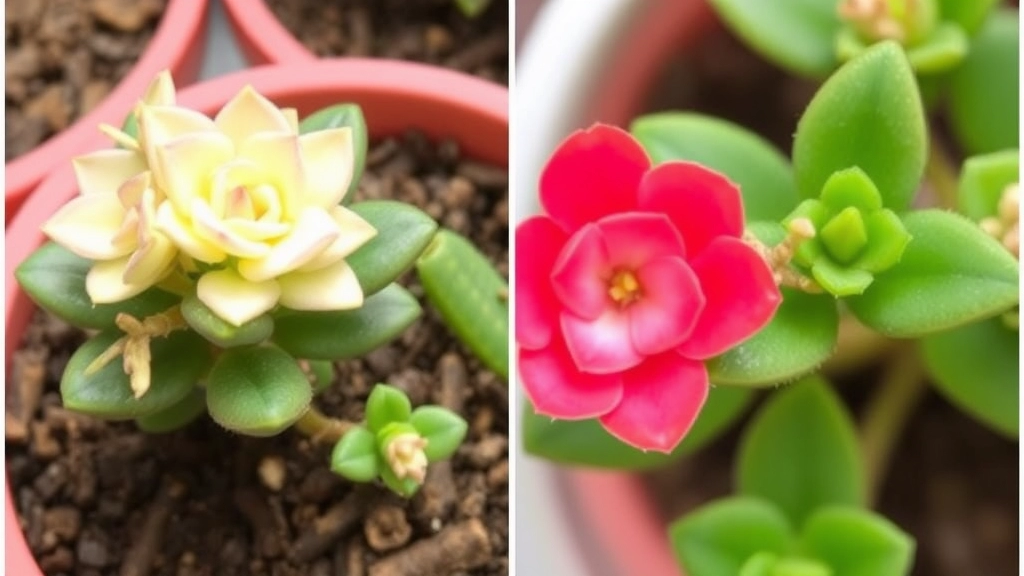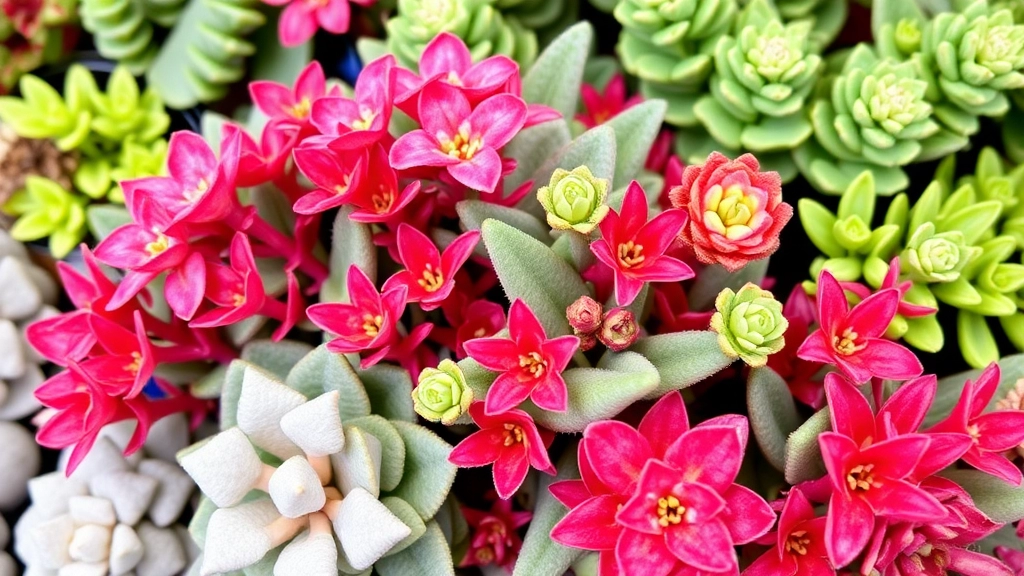Kalanchoe Tomentosa Varieties
Are you curious about the different Kalanchoe Tomentosa varieties? Known as the Panda Plant, these succulents are adored for their fuzzy leaves and unique cultivars like ‘Chocolate Soldier’ and ‘Variegata’. As a plant enthusiast, you’ll find that each variety has its own charm and specific care needs. Let’s dive into the most popular types and how to keep them thriving.
From the striking ‘Chocolate Soldier’ to the rare ‘Variegata’, Kalanchoe Tomentosa varieties offer a range of visual appeal. Understanding their distinct characteristics and care requirements is key to successful growth. Whether you’re a home gardener or a succulent collector, this guide will provide you with essential tips on propagation and maintenance to ensure your Panda Plants flourish.
Are you curious about the different varieties of Kalanchoe tomentosa, commonly known as Panda Plant? You’re not alone. Many plant enthusiasts are drawn to its unique appearance and easy care requirements.
Kalanchoe tomentosa is a succulent native to Madagascar, and it boasts several popular varieties, each bringing its own charm to the table. Here are some of the most sought-after types:
– **Chocolate Soldier**: Known for its striking brown-tipped leaves, this variety is a favourite among collectors. Its unique coloration adds a touch of elegance to any plant collection.
– **Fang**: This variety features leaves that resemble little fangs, making it an intriguing addition to your indoor garden. The distinctive shape and texture can spark conversations among guests.
– **Silver Panda**: With its silvery-grey leaves, this variety offers a softer look. It’s perfect for those who prefer a more subtle aesthetic while still enjoying the benefits of a succulent.
– **Kalanchoe tomentosa var. tomentosa**: This is the classic form of the Panda Plant, showcasing the typical fuzzy leaves that many people adore.
Each of these varieties has its own appeal, making Kalanchoe tomentosa a versatile choice for any plant lover. For those interested in more detailed care tips, check out our [succulent Kalanchoe tomentosa care guide](https://planthq.org/succulent-kalanchoe-tomentosa-care-tips-and-growing-guide/). Additionally, if you’re looking to expand your collection, you might find our [complete care guide for Kalanchoe Blossfeldiana](https://planthq.org/complete-care-guide-for-kalanchoe-blossfeldiana-succulent/) helpful as well.
Distinct Characteristics of ‘Chocolate Soldier’

So, you’re curious about the unique traits of the ‘Chocolate Soldier’ Kalanchoe Tomentosa?
This little gem stands out in the succulent world for a few reasons.
First off, the leaves are a delightful sight.
- Shape & Texture: They’re thick, oval-shaped, and covered in a fuzzy coating that gives them a soft, velvety feel.
- Colour: The leaves sport a lovely green hue, but here’s the kicker: they have a stunning chocolate-brown edge. This contrast makes them visually striking and a favourite among plant enthusiasts.
- Size: Typically, the leaves can grow up to 10 cm long, making them a perfect size for both small pots and larger arrangements.
Now, let’s talk about their growth habit.
- Height: ‘Chocolate Soldier’ usually grows to about 30 cm tall.
- Branching: The plant tends to be bushy, with multiple stems that can give your space a lush, full look.
And let’s not forget about their flowers.
- Blooms: When they flower, they produce clusters of tubular, yellow-orange blooms that are not just pretty but also attract pollinators.
- Flowering Season: They typically bloom in the late winter to early spring, adding a splash of colour when many other plants are still dormant.
These characteristics make the ‘Chocolate Soldier’ a fantastic choice for anyone looking to add a bit of flair to their collection.
Caring for Kalanchoe tomentosa, commonly known as the Panda Plant, can vary significantly depending on the climate you find yourself in.
If you’re wondering how to keep your Kalanchoe thriving, here’s a straightforward guide tailored to different environments.
### Tropical Climates
In warm, humid areas, Kalanchoe tomentosa requires special attention:
– **Light:** Ensure it receives bright, indirect sunlight to prevent leaf burn.
– **Watering:** Water sparingly; let the soil dry out completely between waterings.
– **Humidity:** While it thrives in humidity, too much can lead to root rot. Aim for moderate humidity levels.
### Temperate Climates
For those in temperate regions, the care routine is slightly different:
– **Light:** Full sun is ideal, but partial shade during the hottest part of the day can be beneficial.
– **Watering:** Water every two weeks in spring and summer, reducing frequency in autumn and winter.
– **Temperature:** Protect from frost; if temperatures drop below 10°C (50°F), bring your plant indoors.
### Arid Climates
In dry, desert-like conditions, Kalanchoe can flourish, but adjustments are necessary:
– **Light:** Full sun is essential, as it mimics its native habitat.
– **Watering:** Increase watering frequency during the hot months but ensure the pot has excellent drainage.
– **Soil:** Use a well-draining cactus mix to prevent water retention.
### Indoor Care
Regardless of your external climate, indoor care remains crucial:
– **Light:** Place near a south-facing window for ample light.
– **Watering:** Check the soil moisture regularly, watering only when the top inch feels dry.
– **Fertilization:** Feed with a balanced, diluted fertiliser during the growing season.
For more detailed information on how to grow and care for Kalanchoe tomentosa, you might find our [succulent care guide](https://planthq.org/succulent-kalanchoe-tomentosa-care-tips-and-growing-guide/) helpful. Additionally, if you are interested in other types of Kalanchoe, consider reading about the [best soil for Kalanchoe Blossfeldiana](https://planthq.org/best-soil-for-kalanchoe-blossfeldiana-care-tips/).
Propagation Techniques for Kalanchoe Tomentosa

When it comes to expanding your collection of Kalanchoe Tomentosa, also known as Panda Plant, propagation is an exciting and rewarding process. You may wonder how to effectively propagate these charming succulents.
Methods of Propagation
- Leaf Cuttings
- Select healthy leaves from the parent plant.
- Allow the cut ends to dry for a few days to form a callus.
- Place the leaves on well-draining soil, ensuring they are not buried.
- Water sparingly until roots develop.
- Stem Cuttings
- Cut a healthy stem just below a node.
- Let the cutting dry for a few days to prevent rot.
- Plant the cutting in a pot with cactus mix or well-draining soil.
- Water lightly until new growth appears.
- Offsets
- Look for small offsets or pups at the base of the plant.
- Gently remove them, ensuring some roots are attached.
- Plant them in their own pots with suitable soil.
- Water lightly until established.
Timing and Conditions
The best time to propagate Kalanchoe Tomentosa is during the spring or early summer when the plant is actively growing.
Ensure that the environment is warm and well-lit, but avoid direct sunlight to prevent scorching.
Tips for Success
- Use clean, sharp tools to prevent infection.
- Keep the soil slightly moist but not soggy.
- Be patient; rooting can take several weeks.
When caring for Kalanchoe tomentosa, commonly known as Panda Plants, it’s essential to be vigilant about potential pests and issues that can arise.
### Common Pests:
– **Mealybugs**
These small, white, cotton-like insects often hide in leaf joints. They feed on the plant’s sap, leading to wilting and yellowing leaves.
– **Spider Mites**
Tiny and often unnoticed, spider mites thrive in dry conditions. Look for fine webbing and stippled leaves, which indicate their presence.
– **Aphids**
These soft-bodied insects can cluster on new growth. They can cause leaf distortion and may transmit diseases.
### Issues to Monitor:
– **Overwatering**
This is a common mistake that can lead to root rot. Ensure the soil dries out between waterings. For more detailed care instructions, you can refer to the [complete care guide for Kalanchoe Blossfeldiana succulent](https://planthq.org/complete-care-guide-for-kalanchoe-blossfeldiana-succulent/).
– **Underwatering**
Conversely, letting the soil dry out for too long can stress the plant. Look for shrivelling leaves as a sign of dehydration.
– **Fungal Infections**
High humidity can lead to issues like powdery mildew. Ensure good air circulation around your Panda Plant. For additional tips on maintaining plant health, you might find the [health benefits of Kalanchoe Pinnata extract](https://planthq.org/health-benefits-of-kalanchoe-pinnata-extract/) useful.
### Prevention and Treatment:
– **Regular Inspection**
Check your plants weekly for any signs of pests or issues. Early detection can save your plant from severe damage.
– **Natural Remedies**
Use insecticidal soap or neem oil for pest control. For fungal issues, consider a fungicide or simply improve airflow.
– **Maintain Proper Environment**
Ensure well-draining soil and avoid overcrowding plants. A stable environment reduces stress and susceptibility to pests.
FAQs about Kalanchoe Tomentosa Varieties
What makes the ‘Chocolate Soldier’ variety unique?
The ‘Chocolate Soldier’ Kalanchoe Tomentosa stands out due to its thick, oval-shaped leaves covered in a soft, velvety texture. The leaves have a green hue with a distinctive chocolate-brown edge, making them visually striking. The plant typically grows up to 30 cm tall and produces clusters of tubular, yellow-orange blooms in late winter to early spring.
How do I propagate Kalanchoe Tomentosa?
There are three main methods of propagating Kalanchoe Tomentosa: leaf cuttings, stem cuttings, and offsets. Each method involves allowing the cut ends to dry and form a callus before planting in well-draining soil. Water sparingly until roots develop.
When is the best time to propagate Kalanchoe Tomentosa?
The ideal time for propagation is during the spring or early summer when the plant is actively growing. Ensure the environment is warm and well-lit but avoid direct sunlight to prevent scorching.
What are some tips for successful propagation?
Use clean, sharp tools to prevent infection, keep the soil slightly moist but not soggy, and be patient as rooting can take several weeks. Ensuring the right conditions will help the new plants establish themselves successfully.
How tall does the ‘Chocolate Soldier’ Kalanchoe Tomentosa grow?
The ‘Chocolate Soldier’ variety typically grows to about 30 cm tall. Its bushy growth habit with multiple stems makes it a lush and full addition to any space.
What kind of flowers does the ‘Chocolate Soldier’ produce?
The ‘Chocolate Soldier’ produces clusters of tubular, yellow-orange blooms. These flowers typically appear in late winter to early spring and can attract pollinators to your garden or indoor space.
What is the texture of the ‘Chocolate Soldier’ leaves?
The leaves of the ‘Chocolate Soldier’ are covered in a fuzzy coating that gives them a soft, velvety feel. This unique texture adds to the plant’s appeal and makes it a favorite among succulent enthusiasts.
References
-
Kalanchoe Tomentosa Growing Guide
-
Kalanchoe Tomentosa ‘Chocolate Soldier’
-
Panda Plant Care Guide
